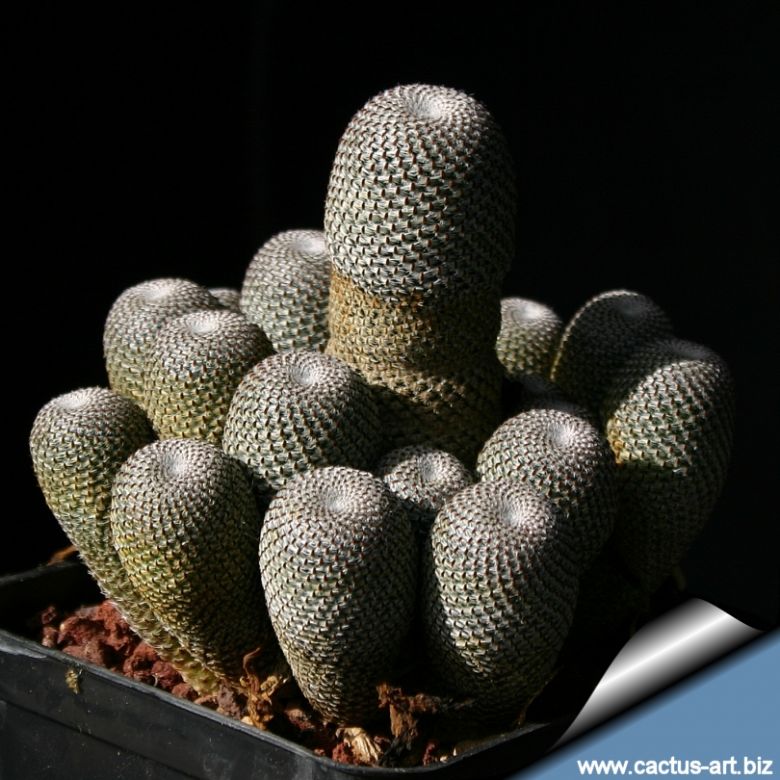
Rebutia heliosa
KK844 Jucanas, Tarija, 3000 m Bolivia. This is a very distinctive plant even without flowers. The “sunny” Rebutia is particularly attractive, thanks to its tiny silver-white pectinate spines and brown areoles, a gem!!!
Origin and Habitat: Bolivia (Near Tarija (Jucanas) on the road to Narvaez)
Habitat: It grows in mountainous areas at an altitude around 2500 m 3000 m over sea level
Synonyms:
See all synonyms of Rebutia heliosa
back
Accepted name in llifle Database:Rebutia heliosa RauschKakteen Sukk. 21: 30, figs. 1970Synonymy: 31
Cultivars
(4):
back
Description: Rebutia heliosaSN|5204]]SN|5204]] (Aylostera heliosaSN|5205]]SN|5205]]) is a small cactus with heads densely covered covered in brown areoles with white short pectinate spines, giving it a silvery appearance. This odd cactus is unmistakable and very distinctive. It is considered by many one of the nicest species.
Habit:It is essentially a miniature plant simple at first, that readily forms a clustering mound of tiny heads.
Stem: Heads compressed spherical to shortly cylindrical 2,5 cm wide, rarely higher than 3 cm or more.
Areoles: Small, brown and narrow, elongated 1-2 mm long, less than 0,5 mm broad, forming 35-40 spirals.
Spines: 24-26 all radials, short, about 1 mm long, distinctively silvery-white, dense, spreading laterally and pectinate, covering almost completely the small stems in a spiral pattern.
Roots: Fleshy tap root.
Flower: Large, funnel-shaped, long-necked, 4 cm in diameter, 4,5-5,5 cm long, orange-red. Tube up to 3 cm long 2-3 mm across, solid for more than half its length, deep rose to orange pink. Tepals orange with lilac mid-stripe.
Phenology: It flowers profusely in spring. (Rebutias are self-fertilizing but aylosteras are not, and the latter can be fooled by introducing foreign pollen and then re-pollinating with its own pollen.)
Fruit: 4 mm in diameter, deep crimson to purple.
Seeds: Hemispheric to helmet-shaped. black, papillate.
Subspecies, varieties, forms and cultivars of plants belonging to the Rebutia heliosa group
 Rebutia densipectinata KK849 f.ma brevispina hort.: This is one of the most remarkable red blooming Rebutias with short, tiny silvery brown spines and purple tinged stem reminding of Sulcorebutia rauschii.
Rebutia densipectinata KK849 f.ma brevispina hort.: This is one of the most remarkable red blooming Rebutias with short, tiny silvery brown spines and purple tinged stem reminding of Sulcorebutia rauschii. Rebutia densipectinata KK849 Jucanas, Tarija, Bolivia 2800m (3000m) Kníže non F.Ritter: (same as: R. heliosa var. condorensis and var. melanistic?) forms a mound of tiny heads covered by white to tan coloure pectinated spines. Blossoms bright red.
Rebutia densipectinata KK849 Jucanas, Tarija, Bolivia 2800m (3000m) Kníže non F.Ritter: (same as: R. heliosa var. condorensis and var. melanistic?) forms a mound of tiny heads covered by white to tan coloure pectinated spines. Blossoms bright red. Rebutia heliosa Rausch: It is a miniature plant that readily forms a clustering mound of tiny heads. The spines are very short, silvery, dense and pectinate, covering almost completely the small stems in a spiral pattern. Blooms orange.
Rebutia heliosa Rausch: It is a miniature plant that readily forms a clustering mound of tiny heads. The spines are very short, silvery, dense and pectinate, covering almost completely the small stems in a spiral pattern. Blooms orange. Rebutia heliosa var. cajasensis Donald: has orange-red or red flowers, larger heads with silvery pectinated spines. It looks pretty like v. condorensis but lighter spined. Distribution: Desfiladero de Cajas
Rebutia heliosa var. cajasensis Donald: has orange-red or red flowers, larger heads with silvery pectinated spines. It looks pretty like v. condorensis but lighter spined. Distribution: Desfiladero de Cajas Rebutia heliosa var. condorensis Donald: The variety “condorensis” specifically describes the clones of the species with dark red flowers, and larger heads. Distribution: Condor pass.
Rebutia heliosa var. condorensis Donald: The variety “condorensis” specifically describes the clones of the species with dark red flowers, and larger heads. Distribution: Condor pass. Rebutia heliosa var. condorensis f. cristata hort.: Crested form.
Rebutia heliosa var. condorensis f. cristata hort.: Crested form. Rebutia heliosa f. cristata hort.: The crested stems are 2,5-4 cm thick and eventually forms a brain-shaped clump 10 to 20 cm across.
Rebutia heliosa f. cristata hort.: The crested stems are 2,5-4 cm thick and eventually forms a brain-shaped clump 10 to 20 cm across. Rebutia heliosa f. monstruosa hort.: each branch, after an initial normal growth, go crazy and starts to produce bumped structures or even dichotomize funnily. This odd cactus is very distinctive.
Rebutia heliosa f. monstruosa hort.: each branch, after an initial normal growth, go crazy and starts to produce bumped structures or even dichotomize funnily. This odd cactus is very distinctive.- Rebutia heliosa var. solisioides hort.
 Rebutia heliosa subs. teresae Kníže, Říha & Šeda: It is a long-spined form. The spines are not quite as appressed and the areoles are not as elongated. The flowers are more intensely red-orange. Distribution: Cajas Pass, near Nogales, North West of Tarija.
Rebutia heliosa subs. teresae Kníže, Říha & Šeda: It is a long-spined form. The spines are not quite as appressed and the areoles are not as elongated. The flowers are more intensely red-orange. Distribution: Cajas Pass, near Nogales, North West of Tarija. Rebutia heliosa cv. Yellow: albinos form.
Rebutia heliosa cv. Yellow: albinos form.
Bibliography: Major references and further lectures
1) James Cullen, Sabina G. Knees, H. Suzanne Cubey “The European Garden Flora Flowering Plants: A Manual for the Identification of Plants Cultivated in Europe, Both Out-of-Doors and Under Glass” Cambridge University Press, 11/Aug./2011
2) David Hunt, Nigel Taylor “The New Cactus Lexicon” DH Books, 2006
3) Edward F. Anderson “The Cactus Family” Timber Press, 2001
4) Willy Cullmann; Gerhard Groner; Erich Gotz “The Encyclopedia of Cacti” Alpha Books 1986
5) Roger Spencer “Horticultural Flora of South-Eastern Australia: Flowering Plants” UNSW Press, 01/gen/1995
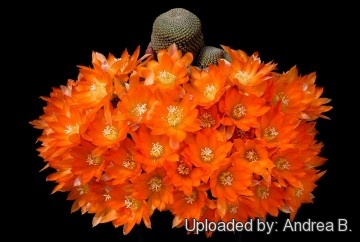 Rebutia heliosa Photo by: Andrea B.
Rebutia heliosa Photo by: Andrea B.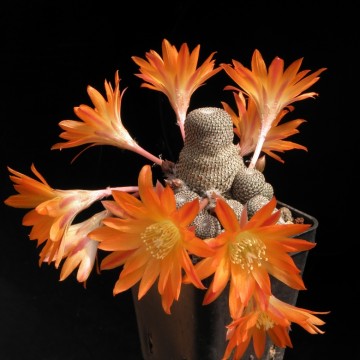 Rebutia heliosa Photo by: Valentino Vallicelli
Rebutia heliosa Photo by: Valentino Vallicelli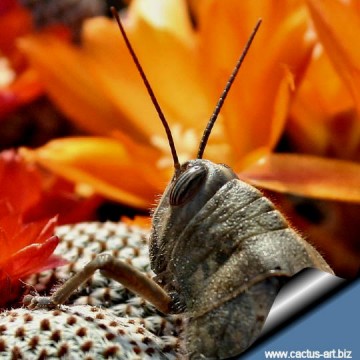 An ''Egyptian Locust'' looking at the blooming R. heliosa. Photo by: Cactus Art
An ''Egyptian Locust'' looking at the blooming R. heliosa. Photo by: Cactus Art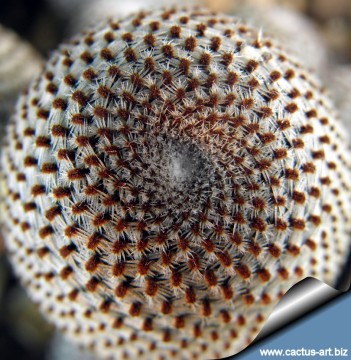 Rebutia heliosa Photo by: Cactus Art
Rebutia heliosa Photo by: Cactus Art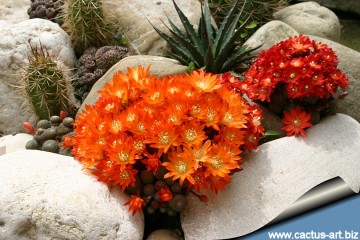 Grown outdoor in the rock garden all year round without any protection against rain and snow. Photo by: Cactus Art
Grown outdoor in the rock garden all year round without any protection against rain and snow. Photo by: Cactus Art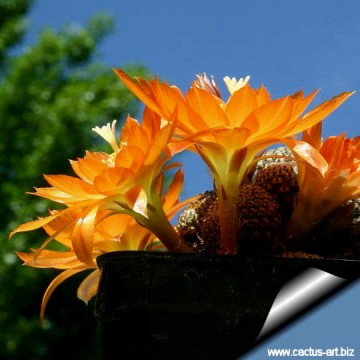 Rebutia heliosa Photo by: Cactus Art
Rebutia heliosa Photo by: Cactus Art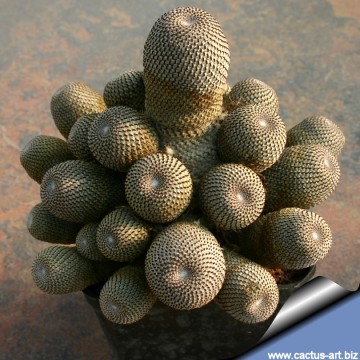 Rebutia heliosa Photo by: Cactus Art
Rebutia heliosa Photo by: Cactus Art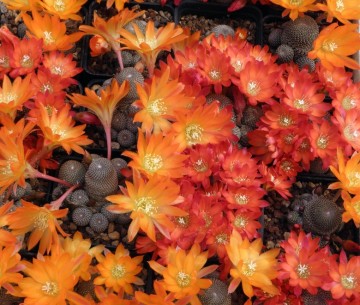 This is one of the most floriferous cactus. Photo by: Valentino Vallicelli
This is one of the most floriferous cactus. Photo by: Valentino VallicelliCultivation and Propagation: These plants come from mountainous areas, so like bright light, cool and dry conditions in the winter; this is important for the flowers as well as for their health. Without this cool winter period (0-10° C) they normally won't get many buds. They have a thick taproot and are of difficult cultivation and rot prone because of a great sensitivity to the excess of watering, not easy to get to any large size on their own roots really a challenge to grow into a large clump. They are commonly grafted to avoid root problems and to make easier to grow. Sun Exposure: Suited for sunny-brightly exposure; can tolerate light shade.
Cultural Practices: Suited for airy exposures. Needs deep pot and good drainage to accommodate its tap root.
It is very cold resistant as low as to -10° C or less for short periods of time. It is a fine plant for a rock garden or container, contrasts well with agaves, yuccas, and low-growing flowering plants.
Pests & diseases: Rebutia heliosaSN|5204]]SN|5204]] is especially prone to root rot, therefore, underpot in a smaller container filled with very porous compost.
Propagation: Cutting as it branches freely from the base; Also can be grown from seeds or graft. Seeds can be sown in the spring or summer. The seedlings should not be disturbed until they are well rooted, after which they can be planted separately in small pots.
Your Photos
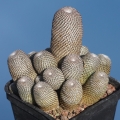
by Valentino Vallicelli
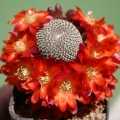
by Valentino Vallicelli
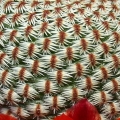
by Cactus Art

by Cactus Art
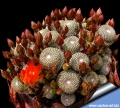
by Cactus Art
























